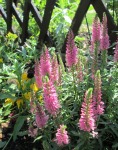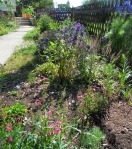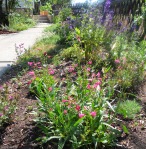Invasive plants in August in Calgary
August 15, 2014
My giant mystery plant
- Height 8′ – 9′
- Leaves
- largest was 12″ ?
- not incised
- not compound
- dichotomous venation
- alternate
- Flowers ?
- drooping green seed pods
- Stem
- green
- tough
My mystery plant is thankfully not a Giant Hogweed.
Characteristics of the Giant Hogweed according to the Department of Environmental Conservation New York
- Extremely toxic
- Height: 10′-15
- Leaves
- huge (up to 5 feet across)
- sharply incised
- deeply lobed
- compound
- palmate venation
- pinnate
- Flowers
- white
- late June to mid July
- umbrella
- Stem
- hollow
- green with extensive purple splotches
- prominent coarse white hairs
- ridged
- 2-4 inches in diameter
- thick circle of hairs at base of leaf stalk
- Seeds
- dry
- flattened
- oval
- 3/8 inch long
- tan with brown lines (oil tubes) extending 3/4 of the seed length that widen at ends
Edibles in August
August 15, 2014
- Echinacea purpurea 12 August ’14
- Wild Currant 15 August ’14
- Wild Currant 15 August ’14
- Wild Currant 15 August ’14
- Wild Currant 15 August ’14
Perennial Onion cepa x proliferum
August 12, 2014
Walking Onion, Egyptian onion, Perennial Onion Allium cepa x proliferum
By 12 August my prolific perennial onions have already been shared with others and I still have lots of bulblets. Visitors to the garden are always fascinated by the way these walking onions bowed over by the weight of the clusters of topsets, if left on their own, can plants themselves for next year’s harvest.
I received mine from a very dear friend Ed, whose garden dates back at least to the 1980s? Since then I have been able to share a lot as well. They are leggy plants and fall over with the weight of the topsets so the need a special place in the garden. I have them with my chives for now.
In her article published in Calgary Gardening Janet Melrose described how the perennial onion grows so well in Calgary’s climate. It is a member of the Allium genus, known as “tree onion, topset onion, walking onion, Egyptian onion and perennial onion.” It is also named “A. cepa var. bulbiferum, viviparum, multiplicans, proliferum.”
Although Melrose recommends fall transplanting, they seem to be so hardy they survive planting in spring and even in summer.
Melrose is unsure of the origin of the name Egyptian onion but did mention that at the time of the Pharoahs, Egyptians believed that “the spherical shape of the bulb and concentric rings of the onions represented eternal life,” but she did not think that was the reason for this common name.
Melrose mentioned that the early leaves are mild and delicious, tasting like spring onions. The topsets are spicy. In early fall the “pungent shallot-looking bulbs” can be harvested.
References
Melrose, Janet. “Edible Portrait: Perennial Onion.” Calgary Gardening. Calgary Horticultural Society. August/September 2014. Volume 28. Issue 7. Page 5.
What’s blooming in August?
August 12, 2014
- Veronica Hybrid ‘Giles Van Hees’ Speedwell August 12, 2014
- Monkshood 12 August ’14
- Silver willow 12 August ’14
- Ligularia12 August ’14
- Rudbeckia fulgida 10 August ’14
Bees, Butterflies in another Calgary garden
August 11, 2014
Speyeria cybele Great Spangled Fritillary

 |
Thanks Kevin for taking these photos of my French Lavender and butterfly and the Veronica Speedwell Candied Candles buzzing with bees with your nifty iphone 5 and its cool image software. |
Perennial of the week Speedwell Veronica ‘Candied Candles’
August 7, 2014
 |
 |
Speedwell ‘Candied Candles’ Veronica longifolio pink, acquired from Epic Plants
Height: 20″/50cm
Width: 14″/35cm
Spread: 7-9
Blossoms: Spires, rose pink,
Foliage: Tidy, thick clump, attractive dark green leaves
Bees: This plant is so full of bees that it is a challenge to find branches easy to cut without disturbing the bees’ work
Cut flowers: excellent tall, handsome flowers that goes well with so many other flowers blooming at this time
Companions: butterfly plant; Joe Pye Weed; Pink roses; Bee balm (unfortunately for the plant, I have been cutting too much because I love the leaves for my tisane);
Notes for 2015: It needs anther perennial at the base of the plant that grows high enough to hide ‘Candied Candles’ lower leaves that turn brown.
Garden Bed: Poppies and Roses, a perennial border along the inner corner fences at the northeast of the lot. This well-drained area with fertile soil gets lots of late morning and early afternoon light from the south and late afternoon sun from the west.
Gardening notes for 7 August 2014.
We made our first trip to Bow Point Nursery to the west of Calgary. Their healthy perennials, grasses, native plants, shrubs and trees are inspirational. I purchased 4 6″ plugs of Silver Willow at $5 each, the plant that is recommended by the Calgary Horticultural Society to replace some (not all) of my Wolf Willow and Prairie Sage, both of which have the same silvery colour but tend to spread via strong roots. They have really beautiful and healthy larger specimens at $70 for the gallon sized. Mine will take years to be that big. I also purchased 1 6″ plug of Heart-leaved Arnica. Arden from Wild about Flowers. I first noticed this wild flower at Waterton National Park on the Bear’s Hump walking trail during their wild flower festival. When planting native plants I am patient and plan for future years. Often in the first year the plants sleep. Then in the second or third year they bolt and some, like wild strawberries, may even need to be divided. While we were at Bow Point Nursery Carmen helped me identify a plant I have in my garden without a label. It is the elder berry. The branches of the tall, lush and healthy specimens at their nursery were laden with ripe berries. I had just transplanted mine to find it a better home because many of the leaves appeared to be shriveled. She also identified the goose berry. I think I have a small specimen in my garden too.
Bees and butterflies are loving my garden right now. The lavender and mother-of-thyme are alive with them.
Tisane from garden in August
August 6, 2014
This week the lemon grass is beginning to produce more leaves so I am adding these to my tisane that now has lots of rose blossoms from the Morden Sunrise, and the plentiful pink rose (purchased at the Calgary Horticultural Society’s Spring show in April 2014), wild bergamot, mints, stevia. I drink it hot first then refrigerate the rest for later. I have dried some stevia and bergamot in the Nesco food dryer but I somehow cannot imagine my mid-winter tisane coming anything close to the taste and fragrance of the summer brews.
I think the tarragon is quickly reaching its expected growth to 60 (H) x 35 cm. Unfortunately while I was busy with other important things, it went to seed so I am scurrying to prune it back without losing these amazing leaves. I kept thinking of my Persian friends who might like to have bowlfuls of this on their tables this week. But I don’t know if they like it when there are seeds too. It was at its best a few weeks ago. Note to myself, harvest more earlier and give lots away. I have promised roots to friends and this is something to do as soon as we have a forecast of cooler weather with rain.
The walking onions or Egyptian onions also need to be shared perhaps with the community garden. Next year I am going to give them more support early on. They grow to 4′ quickly in July. I am not sure yet how much of the plant is edible as some parts of it are quite tough. Preparing the onion “seeds” is easier with parboiling. I’ll be replanting soon. I want to see how big these seeds will grow.
The carrots are coming along but need a lot of thinning. I pulled the spinach plants that had gone to seed to give the carrots more room and cannot find my spinach seeds for the second harvest. This happens every year! I need a better seed organization system.
I gathered spinach, beans, peas, carrots, parsley, tomatoes, tarragon, Egyptian onions and sauteed them all together in coconut butter. I felt guilty about not sharing my meal and wanted to call Victoria or Audrey over to join me. I froze some tarragon without blanching.
I just blanched and froze some rhubarb but there is lots more now so that needs to be done soon.
I am not quite sure where to plant my new hops plant. I want it to add height but I don’t want it to take over. It is so enthusiastic.
That large poplar tree on the north side of Tara’s Island bed sucks everything dry underneath it, suffocates what it can with successive shedding of its various seed forms and shades the rest until everything shrivels. It can transform lovely compost into a dry dust-filled net of its own fine roots in a matter of weeks. It embarrasses me with its plume of summer snow pollen that spreads for blocks and continues for weeks not days. I am considering adding more of the Prairie Sage and even waves of Iris Germanica as foliage and mounds of cranesbill geranium and lamium around the Maltese Cross. Even though the hare ate most of my daisies I will continue to plant more there. I was hoping for white and red blossoms. Now I just want anything that will grow there.
The goats beard or the hyssop never grew more than inches and I am glad I kept their labels or they would have unrecognizable. They have been moved to the newly redesigned Friendship Garden outside the fence at the back entrance. This is a lovely spot close to the water outlet and rain barrel with lots of sun and lots of compost from my Sunnyside bulk bags.
I have been deadheading and closely watching my new additions to the garden purchased at Rona’s sale last week which includes Shasta Daisies, Blanket flowers, Karl Forester Grass and Feather Grass . I am impressed with the display of perennial plants on sale this week as they are all Perennial Plants of the Year with most of them (but not all) highly recommended for Calgary’s Zone 3. I placed one Feather Grass which is probably more of an annual here, in a large planter and the other in the Coach Light Island. I am gradually trying to replace the plants that need work pruning and support with plants on the Perennial Plants of the Year lists that will in the end be more sustainable. The extensive garden outside the fence, a 3′ – 4′ perennial border along the two laneways and corner are high maintenance. Weeds love the sun-filled space. Big trucks drive over edging plants which in some cases helps me by keeping an edge which is not easy to do on a utilities lane. I started in 2007-2008? by letting my gifted perennials grow as much as they wanted while I kept adding the least expensive soil amendments. Over the last couple of years, as much of the garden in the front and back expanded and filled in with more sustainable plants since I first began in 2007-2008, I can now work on corralling the gifted perennials into contained spaces and letting plants like sedums, Morden Sunrise, David Thompson rose, Shasta Daisy*, liatris, Stella d’Oro, join the enthusiastic prairie sage, cranesbill geranium , Iris Germanica and wild currant.
There are still some sweet peas outside the fence that need support but parts of the fence still need painting. Heat and or/rain and absence have made this summer-long project quite a challenge.
End of July 2014
August 1, 2014
- Thyme, lavender, clustered bellflower 1 August ’14
- Lavender 1 August ’14
- Thyme, Royal candles 1 August ’14
- Clustered bellflower, delphineum 31 July ’14
- Penstemon, clustered bellflower 31 July ’14
- Penstemon 31 July ’14
- Day lily, Delphineum 31 July ’14
- Morden Sunrise Rose 31 July ’14
- Day Lily 31 July ’14
- Daisies 31 July ’14
- Daisies, Day Lily 31 July ’14
- Delphineum, Romeo Cherry 31 July ’14
- Veronica Speedwell ‘Candied Candles’ 31 July ’14




























